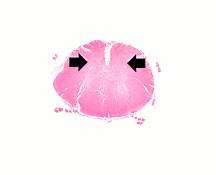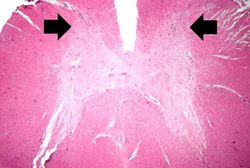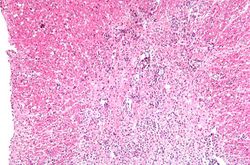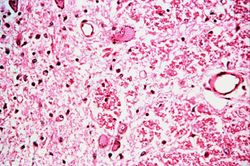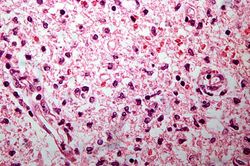Difference between revisions of "IPLab:Lab 8:Poliomyelitis"
Seung Park (talk | contribs) |
Seung Park (talk | contribs) |
||
| Line 19: | Line 19: | ||
* <spoiler text="How does poliovirus cause cell death?">Poliovirus replicates inside neurons and causes lysis of the cell.</spoiler> | * <spoiler text="How does poliovirus cause cell death?">Poliovirus replicates inside neurons and causes lysis of the cell.</spoiler> | ||
* <spoiler text="What is the mode of transmission of poliovirus?">Poliovirus is an enterovirus that is usually acquired from contaminated water. It has been effectively controlled by immunization; however, among the nonimmune it causes a nonspecific gastroenteritis. In a small fraction of the vulnerable population, it can invade the nervous system where it attacks lower motor neurons.</spoiler> | * <spoiler text="What is the mode of transmission of poliovirus?">Poliovirus is an enterovirus that is usually acquired from contaminated water. It has been effectively controlled by immunization; however, among the nonimmune it causes a nonspecific gastroenteritis. In a small fraction of the vulnerable population, it can invade the nervous system where it attacks lower motor neurons.</spoiler> | ||
| + | |||
| + | == Additional Resources == | ||
| + | === Reference === | ||
| + | |||
| + | |||
| + | === Journal Articles === | ||
| + | |||
| + | |||
| + | === Images === | ||
| + | |||
| + | |||
| + | == Related IPLab Cases == | ||
| + | |||
{{IPLab 8}} | {{IPLab 8}} | ||
[[Category: IPLab:Lab 8]] | [[Category: IPLab:Lab 8]] | ||
Revision as of 04:22, 23 August 2013
Contents
Clinical Summary[edit]
Six days before his death, this 31-year-old white male became acutely ill with fever followed by an ascending paralysis which began in his feet. Three days later he was hospitalized because of difficulty in breathing. A lumbar puncture was performed and the patient's spinal fluid contained increased protein and polymorphonuclear leukocytes (4.30 PMNs/cmm). He died on the third hospital day.
Autopsy Findings[edit]
At autopsy, the thoracic and lumbar portions of the spinal cord were softer than normal and focally hemorrhagic.
Images[edit]
Study Questions[edit]
Additional Resources[edit]
Reference[edit]
Journal Articles[edit]
Images[edit]
Related IPLab Cases[edit]
| |||||
An infiltrate is an accumulation of cells in the lung parenchyma--this is a sign of pneumonia.
